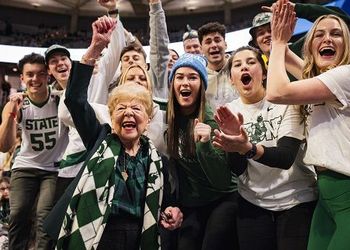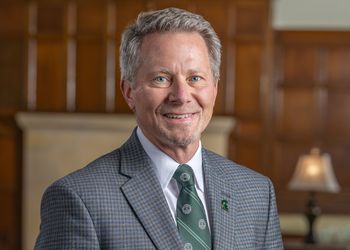Feature: A New MSU Center for User Interfaces

Modern technology is often limited by interfaces that are not easily usable or accessible, and a new MSU center offers solutions .
We are all amazed at the speed and vast reservoirs of information made available to us through technology. But, is there any computer user who hasn’t wanted to pick up the computer and throw it through the window?
Sometimes the reason is hardware failure or viruses or our own growing impatience. But the reason is just as likely to be poorly designed software or information systems or web pages. We can now order pizzas online. But if you are blind and the text of the Web site is “buried” within the graphic, the screen reader that reads the site aloud cannot find the text—the site is not accessible.
We can search for almost anything by keyword but if we get too many responses to our queries, the results are not useful. And if we find the exact site we want only to discover that there are too many and confusing ways to navigate the site, the site is not usable.
A large insurance company is doing advanced research on older adults—their primary clients—and are learning how aging eyes track across Web sites, information that helped it develop a highly accessible, useful, and usable site. What makes the difference is accessibility research and usability evaluation.
Usability and accessibility principles have increasingly become an essential component of technology advancement in a computer literate world. Designing Web sites that are more intuitive, easier to navigate, and accessible improves productivity, decreases development costs, increases customer satisfaction, and empowers people with disabilities to work more effectively.
In 2002 Michigan State University’s then-Provost Lou Anna K. Simon encouraged University personnel to consider bold efforts that represent a substantial amount of thought, vision, and to a certain extent, risk, and turn them into venture capital of academic progress that benefit both external and university interests. The Division of University Outreach & Engagement accepted her challenge and envisioned what is now a world-class, state-of-the-art facility for usability and accessibility evaluation, research, consulting, and teaching.
Following a feasibility study that included travel to other usability organizations around the United States and a year of reconstruction and renovation of a little-used space on the garden level of the Kellogg Center, MSU’s Usability & Accessibility Center (UAC) was officially opened at a national conference held on our campus in October 2004. President Lou Anna K. Simon cut the ribbon and commented:
Part of the key to being a land grant university is giving access to people to cutting edge knowledge. The really neat thing about this Center that reflects Michigan State University, and why it's an exemplar, is that it involves partnerships across the university and it provides full access to all the things Michigan State University has to offer.
The Center’s Work
As a cross-campus unit, the UAC provides leadership in evaluating the degree to which new interface technologies are useful, usable, accessible, and appealing to a broad cross-section of people.
The Center serves as a link between university knowledge and external clients and users.
- It provides excellent usability and accessibility consulting for university, commercial, and governmental organizations.
- It establishes a network of collaborators both across MSU departments and with other organizations to conduct innovative and vital research on usability methodologies and accessible Web design topics.
- It employs graduate and undergraduate students who gain real-world experience in planning and running usability tests as lab associates and who become employable in a wide-cross section of businesses and industries, government agencies, and non-profit organizations.
- It serves as a regional hub for professional, scholarly, and public discourse about usability and accessibility, holding an annual conference as well as lectureships with notable experts and scholars.
On the business front, the UAC offers a variety of products and services that include formal usability evaluations to help companies understand what aspects of the products need user interface and accessibility enhancements before customers can enjoy an effective, satisfying experience with their products.
Many inquiries and requests have come to Director Sarah J. Swierenga since she first came on board in August 2004. (See Sidebar for Sarah’s bio.) One example is a multi-university research project that examines how blind people form mental models of Web site organization, so that better tools can be developed to enhance their ability to navigate Web sites using assistive technologies. Another project studies what types of course components—for example, lectures, interactive demonstrations, on-line discussions, or e-mail—are most effective for students in e-learning environments. Another is evaluating a Web site’s usability and giving recommendations for its redesign.
The Center’s Facility
These kinds of projects are just the beginning. The new Center is available for use by businesses and organizations, by university scholars, by students, by those who need consulting and testing on usability and accessibility, by those who are looking for training, and by those who just need a facility to rent for conducting focus groups or videoconferencing meetings.
The Center’s state-of-the-art facilities were developed in collaboration with prominent figures in the field of usability and accessibility research and facility design. Drawing on examples and expertise from some of the best labs in government, education, and industry, the MSU team created a facility that incorporates cutting-edge technologies and multipurpose spaces within an aesthetically appealing and accessible business environment. Each of the rooms in the facility has multiple purposes and capacities, and all spaces protect the privacy of individuals and accommodate those with disabilities.
For User Testing– The testing space is equipped with computers; digital video, audio, and screen recording equipment; a document camera; Internet connectivity; and white boards. Participants are asked to perform a variety of tasks using a Web site or information technology product. Such tasks might include transferring funds from a checking to savings account in a banking Web site, or finding and purchasing a product from an online store.
For Observation – Clients can observe the test activities from observation rooms through live video and audio feeds to individual computers. Mixing and other production equipment are used to create picture-in-a-picture output for live viewing as well as for recording for later analysis and reporting. Observation spaces are also equipped with large video and audio output equipment (large LCD monitors, projectors, etc.).
For Focus Groups- The focus group space is equipped with digital video and audio recording equipment, operated from a separate control room. The facility allows for both the recording of focus groups as well as their live observation. The space is also equipped with a wireless facilitator microphone, document camera, projector, large LCD SmartBoard, video and audio conferencing capacity, Internet connectivity, and a laptop.
For Teaching and Training- The Internet-supported computer training room is equipped with a projector, instructor microphone, whiteboards, and digital video and audio recording devices. It includes workstations for nine learners and one instructor. Each workstation provides a computer connected to both the Internet and also to a classroom network that allows the instructor to connect any workstation to the projector from a touch screen control panel and, if desired, take control of its keyboard and mouse to demonstrate problems a learner may be working on and also interact with the problems directly. The room’s furnishings encourage interaction and collaboration among learners. The room's digital video and audio equipment make it possible for training sessions to be distributed via videoconferencing and/or recording on a variety of media.
For Videoconferencing and Audio conferencing- The facility has the capacity to originate and participate in video and audio conferences locally (within the facility) and globally from several of its spaces. Besides meetings, the capacity can be used to conduct focus groups and other research at a distance, connect participants from multiple locations in a single activity, or offer distance education and training.
Facilities Rental– The state-of-the art facilities of the UAC are available on a fee-for-service basis to organizations, researchers, practitioners, and others. The Center offers hospitality services (including reception and a kitchenette) and digital video and audio recording and production services.
Director Swierenga invites alumni to seek additional information through the Web site at www.usability.msu.edu or by e-mailing her at uac@msu.edu. She and her staff would be happy to set up a time for you to tour the facility and give you a demonstration of the work of the Center.
Diane L. Zimmermanis director of administration for MSU's Office of University Outreach & Engagement (UO&E) and Burton A. Bargerstock is UO&E director of communication and information technologies.
Sarah J. Swierenga, Ph.D., C.P.E., is the first director of the MSU Usability & Accessibility Center. Sarah provides leadership for collaborative initiatives across MSU and with government agencies, nonprofit organizations, and the private sector. She brings nearly 20 years of experience as both researcher and practicioner in both commercial and military environments. She formerly held a joint appointment as a senior human factors research psychologist in the University of Dayton Research Institute (UDRI) and visiting assistant professor of psychology in the Psychology Department. Previously, Sarah was a consulting human factors engineer at LexisNexis for ten years, providing user interface design and usability consulting on numerous products. Additionally, she led a corporate accessibility compliance initiative, providing technical consulting on over 50 products, creating an organizational strategy for implementing federal Section 508 standards, and making the products accessible for people with different kinds of disabilities. Sarah co-authored Constructing Accessible Web Sites (APress, 2003), and has presented topics on accessible Web site design, usability techniques, and e-learning effectiveness.



